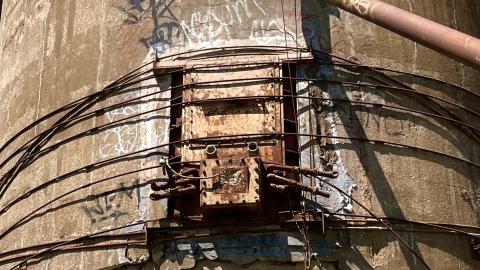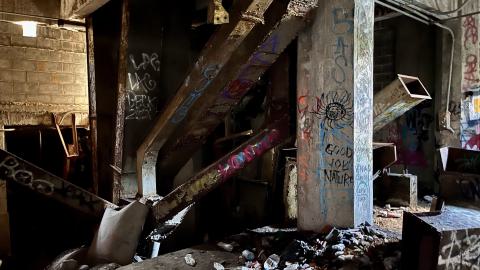Hazards
There's potential risk in getting a trespassing call, although when I went there was no on-site security. I saw some older mentions of security escorting people out, but I'm unsure what the status of that is currently. Might have been discontinued once the state lost the land. Floors are a risk, so watch where you're going. I didn't get a good look at the stairs on the outside, but I wouldn't recommend using that method to get to the top, as they aren't in great condition.
Finally, air quality is poor, so a 99.97% respirator is recommended for asbestos. Lots of rusty things to cut yourself on, so don't be stupid.
History
The Industrial agricultural work goes all the way back to the early 1800’s on this land, where it was home to the largest grain elevators in the city of Chicago. In 1832, the silos caught fire and were greatly damaged to the point where they had to be rebuilt with cement. This was the first time an incident had taken place on this site, but it certainly wasn’t the last. The usage as a grain storage and elevator continued until 1905, when a spontaneous combustion explosion caused a fire that quickly spread. The building, made from sheet iron and cement, was consumed by flames within an hour, and tragically killed several workers in the process.
Despite this, no time was wasted to ensure that grain processing would keep running, which brings us to construction of the Damen Silos. Designed and constructed in 1906 by the John S. Metcalf Company, on behalf of the Topeka & Sante Fe Railroad, the Damen Silos were used as a grain processing and storage facility. John Metcalf was a well-regarded civil engineer at the time, and his design was meant to ensure no more incidents were to happen at these silos (ominous foreshadowing). When constructing the Damen Silos, Metcalf added vents and windows, along with having a boiler system that was funnelled with water from the Chicago River. His eloquent design had an elevator, a powerhouse, 35 storage silos, and is essentially the Damen Silos we know today. For you nerds, here are some of the design blueprints.
Before continuing, I wanted to mention that grain dust is very dangerous. The four major explosion risks of grain dust are:
-
Dispersion
-
Confinement
-
Oxygen
-
Ignition (of course)
When processing grain, three of those four risks will always be present. All that is missing is an ignition source. However, in what was such a lucrative industry at the time, those risks were going to be taken. In 1932, yet another grain dust explosion took place. The four quick explosions took place in the Santa Fe Elevator’s workhouse, one of the buildings adjacent to the silos. The silos themselves were unharmed, however two men were killed in the ensuing blaze. At this point the Silos have had a kill count rivaling a COD lobby. But hey, accidents happen, right?
The Damen Silos ran without any problems until 1977, when the final explosion happened. This time it happened within the grain elevator, and caused significant damage. The damage caused from this explosion, along with the majority of the grain industry moving away from Chicago, ended up being the end for the Damen Silos. The land was sold to the city, and has been vacant ever since.
Over the years, there were rumblings on what the state was going to do with the silos. With the historical significance of the building, there are many who are hoping for the restoration of the building. Unfortunately, things do not seem to be going that way, as the State of Illinois auctioned off the land in October of 2022. Michael Tatin Jr., owner of MAT Asphalt, won the auction for the land in November 2022 for $6.52M USD. MAT Asphalt has been at the center of controversy for locals and activists alike, with their McKinley Park plant being the subject for complaints since its opening in 2017. The community even formed a group - “Neighbours for Environmental Justice” - to voice their concerns about the impact of the plant, including air pollution, truck traffic, and odors. A class action lawsuit was filed against MAT Asphalt, with a $1.2M settlement being approved in December of 2023. Needless to say, they were not thrilled that the state allowed Mr. Tatin to purchase the land.
Despite the significant history of the Damen Silos, Tatin’s plans for the land is to demolish the silos and to replace them with the corporate headquarters for his businesses, including MAT.
In December of 2024, the Army Corps of Engineers approved a permit for the demolition of the buildings. The permit represents approval on the federal stage, which puts the Damen Silos merely one step away from demolition, with that being approval from the city.
About this location
.
Albums 1
Short On Time
Was in a rush and barely had any time to hit this, not even 30 minutes to explore this site, which was really unfortunate because I really wanted to get to the top of the silos. But knowing that I'd p...





5 months ago
demolition is soon to commence on these buildings, heavy equipment is on site as per some locals